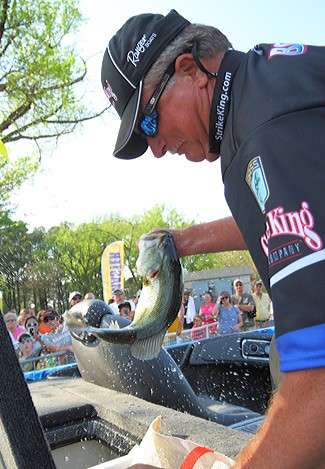
In the next two lessons we'll cover a couple of the more popular warm weather flipping and pitching patterns that we encounter as bass anglers. The first one we'll talk about is pitching to suspended bass in standing timber on channels. The second will be flipping and pitching summertime docks.
Many reservoirs around the country have standing timber along river and creek channels. Typically the water will be deep in these spots, sometimes as much as 40 or 50 feet. But remember, deep is a relative term. In a shallow lake, deep might be 5 or 6 feet.
The idea here is that the bass will be relating to the wood because it's near the channel, however deep that might be. Never forget that. It's one of the most important concepts when it comes to catching these fish. They're on timber because it's near a channel — deep water.
The mistake a lot of anglers make is that they fish the base of the trees. They work their baits on the bottom thinking that's where the fish are located. Nothing could be further from the truth. Most summertime bass relating to standing timber will suspend in it, not be at the bottom of it.
My favorite technique is to pitch a worm to the trees. If the water's clear, I like the Strike King Rage Anaconda in watermelon with red flake. If the water has a little tint to it, I like to go with something that makes a little more vibration such as a Strike King Rage Thumper in a darker color like plum or junebug.
Regardless of which worm I select, I always go with heavy tackle. I'll typically weight my worm with a 1/2-ounce Tru-Tungsten Denny Brauer Flippin' Weight and arm it with a 5/0 Mustad Tube Hook or a Mustad Denny Brauer Flipping Hook. I'll use heavy fluorocarbon line and a stiff American Rodsmiths rod with a powerful Ardent reel. You need to get them out of the wood before they wrap you and ultimately get loose.
All I do when I'm fishing trees is to pitch the worm out, let it fall a few feet and then work it through the limbs. Almost all of my bites come when the worm drops over a limb. I have occasionally caught bass bouncing my bait around in the tree, but mostly that's a waste of time.
Early or late in the day, or when there's a lot of cloud cover, the bass will likely be fairly shallow. I usually start fishing around 6 or 8 feet under those conditions. When the sun's out and it's really bright I drop down into the 12-15 foot range, sometimes even deeper than that.
There's one thing about this kind of fishing that you should never forget. If you catch one bass from a tree, you're likely to catch a bunch. They school tight in the wood at this time of the year. And, even if you only catch one or two from one tree, make sure you come back in an hour or two. I guarantee you you'll catch more once it settles down.
Up to this point I've been talking about worms. Most of the time that'll be your best choice when it comes to lure selection. Most times isn't always, however. Occasionally the bass will take a liking to a jig when they're ignoring worms.
My favorite jig is a Denny Brauer, 1/2-ounce Strike King Premier Pro-Model Jig in Texas Craw with a green pumpkin Denny Brauer Strike King Chunk on the back. It looks exactly like the bluegill that are suspended in the trees with the bass.
Give some of my suggestions a try this summer when you're out bass fishing. You'll add catching to your fishing.





